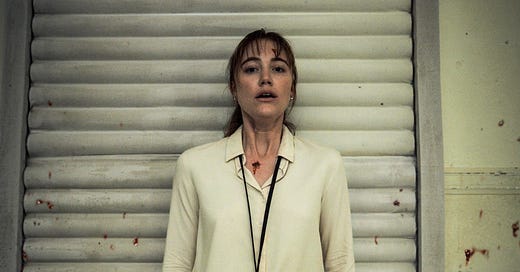Horror show
Horror movies, a reliable genre at the box office, have been struggling this year. Should Hollywood be concerned?
The Gist
Horror movies, once reliable at the box office, have faced headwinds this year, with a few exceptions.
The exceptions have largely been IP-driven, raising questions about a genre that has generated original hits in recent years in a market where those are few and far between.
There’s also the question of whether the genre has become oversaturated; over two dozen horror movies were on the calendar this year.
36 years after “Beetlejuice” was released, its sequel, “Beetlejuice Beetlejuice,” was summoned into theaters over the weekend and earned $110 million in the US. It’s the second-best September opener of all time, after 2017’s “It.”
Meanwhile, “Alien: Romulus” crossed the $300 million mark, reaching $314 million worldwide. It’s more than its predecessor, 2017’s “Alien: Covenant,” which topped out at $240 million.
They mark some of the few bright spots for the horror genre at the box office this year (or in the former’s case, horror adjacent. Let’s call it a horror-comedy for the sake of argument). A usually reliable genre for movie theaters has raised questions this year about its durability. Often in recent years, there’s at least one horror breakout hit early in the year — think “Get Out” in 2017, “A Quiet Place” in 2018, “The Invisible Man” in 2020, “M3gan” in 2022, and so on. This year, as I observed in July, the first half was abysmal.
“Once a bullet-proof, can’t-miss genre, the audience response to horror films over the past year or so has been mixed to the point of requiring a reassessment of the marketplace,” says Paul Dergarabedian, Comscore’s senior media analyst.
Prior to “A Quiet Place: Day One,” which opened in late June and grossed $261 million worldwide, the most a wide-release horror film had earned globally was $54 million, according to Comscore data. The movie? “Night Swim,” which opened way back in January.
The second half of the year has shown improvement: There’s “Day One,” which performed well as a prequel-spinoff (but still grossed less than the other installments in the franchise); “MaXXXine,” which grossed the most of the low-budget “X” trilogy; the aforementioned “Romulus” and “Beetlejuice Beetlejuice”; and the breakout hit “Longlegs,” which surged to over $100 million worldwide and cost under $10 million to make.
But of those, only “Longlegs” isn’t a sequel or franchise installment, and the potential hits on the horizon and into next year fall into that category: “Smile 2” this year; “Wolfman” in January; sequels to “M3gan,” “The Black Phone,” and “Five Nights at Freddy’s” next year; new installments in the “Saw” and “Conjuring” franchises; and “28 Years Later,” the sequel to “28 Days Later.” Horror is the rare genre where original ideas have struck gold in a movie market that has otherwise heavily relied on IP over the last decade-plus. Could that be in danger?
“We’ll still see [original hits] because it’s the genre that studios are still willing to take some risk on,” Shawn Robbins, founder of Box Office Theory, told me. Indeed, a movie like “Longlegs” comes out of nowhere, and is almost impossible to predict.
But there’s another potential concern for the genre. Industry analyst David A. Gross noted in his latest report that there were 28 horror movies scheduled for release through the end of the year and that more could be added to the calendar; there were no more than 21 horror movies in any of the previous seven years, according to Gross, prompting him to ask: Are we getting to a point of saturation?
Dergarabedian says that audiences have become “accustomed to a certain level of horror movie quality” and “have perhaps become more discerning.” With that in mind, of the dozen-and-a-half wide-release horror movies so far this year, only a few of them have over an 80% Rotten Tomatoes critic score.
Robbins notes that part of the oversaturation could be attributed to last year’s Hollywood strikes.
“Studios needed to fill the release calendar, especially early this year when delays from the strikes were still being felt,” he says.
Next up this Friday is “Speak No Evil,” which if you’ve attended any movie over the last several months you’ve probably had to sit through the trailer for (the relentless marketing has become a meme).
That movie is coming from Blumhouse, the production studio known for its horror hits. But its flops this year — from “Imaginary” to more recently “AfrAId” — exemplify the headwinds facing the horror genre. And its upcoming slate — from “Wolfman” to “M3gan 2.0” to the “Five Nights” sequel (and “Speak No Evil” is a remake) — represents the emphasis on IP.
Hopefully the next original breakout is right around the corner.
Beyond the Traverse
🕷️ “Shang-Chi” director Destin Daniel Cretton is returning to the MCU to direct its fourth Spider-Man movie.
💥 The New York Times dives into how pro athletes aren’t hiding their anime fandom.
ICYMI: I observed this trend in my piece on the anime boom in July.
🧹 Warner Bros. Discovery’s CFO said that a sequel to “Hogwarts Legacy” — the highest-selling game of 2023 — is “one of the biggest priorities” for the company (obviously).
🐉 George RR Martin aired his grievances over “House of the Dragon” season two in a now-deleted blog post.






I would never bet against the horror genre long term. This is a weird year because of the strikes and contraction. Horror movies and porn will outlive the apocalypse.
Funny, I was rewatching Longlegs when I pulled this article up. I worry about over-saturation, but I’m also optimistic that original ideas will still get through. Still think 2022 was the best year for horror in ages, what with Barbarian, Smile, Talk to Me, and many more.